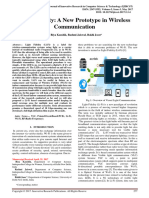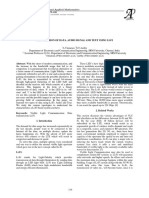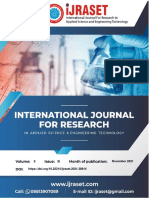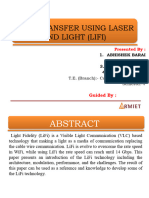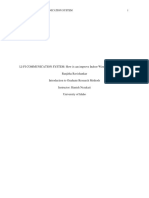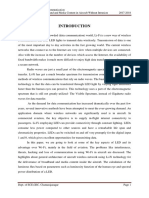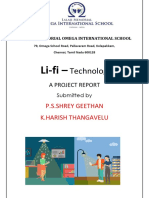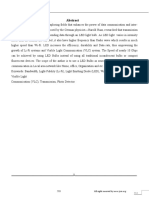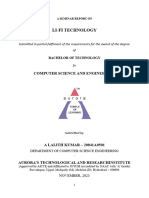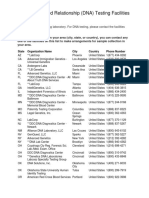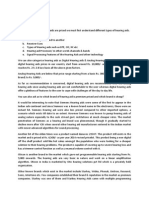Professional Documents
Culture Documents
Text Data Transfer Using Li-Fi Communication
0 ratings0% found this document useful (0 votes)
42 views4 pagesA new and innovative technology called Light
Fidelity (Li-Fi) has been developed
Copyright
© © All Rights Reserved
Available Formats
PDF, TXT or read online from Scribd
Share this document
Did you find this document useful?
Is this content inappropriate?
Report this DocumentA new and innovative technology called Light
Fidelity (Li-Fi) has been developed
Copyright:
© All Rights Reserved
Available Formats
Download as PDF, TXT or read online from Scribd
0 ratings0% found this document useful (0 votes)
42 views4 pagesText Data Transfer Using Li-Fi Communication
A new and innovative technology called Light
Fidelity (Li-Fi) has been developed
Copyright:
© All Rights Reserved
Available Formats
Download as PDF, TXT or read online from Scribd
You are on page 1of 4
Volume 8, Issue 1, January – 2023 International Journal of Innovative Science and Research Technology
ISSN No:-2456-2165
Text Data Transfer Using Li-Fi Communication
V. Parthasaradi1*, T. Senthil Kumar 2, R. Aswin Saravanan3, A. Andro Edwin4,
M. Yohesh5, S. Kamalesh6, K.K. Shanthosh Shree7, R. Deepa8
1*,2,7
Assistant Professor, Department of Electronics and Communication Engineering,
E.G.S. Pillay Engineering College, Nagapattinam, Tamilnadu.
3-6
UG Scholar, Department of Electronics and Communication Engineering
E.G.S. Pillay Engineering College, Nagapattinam, Tamilnadu.
Abstract:- A new and innovative technology called Light
Fidelity (Li-Fi) has been developed in the past few years
which are an alternate solution for wireless fidelity (Wi-Fi).
Li-Fi uses light source as a transmitting medium for data
transmission. The data is transmitted by flickering the light
source (i.e. switching them On and Off) at a speed that
cannot be noticeable to the eye. In this proposed article,
wireless data transfer b e t w e e n t w o systems is
established with the support of Li-Fi technology. Here
data is transmitted from Tx PC via the LASER module
that is driven by the Arduino UNO. On the receiver side
data will be received on Rx PC using the photodiode (Solar
panel), which is also connected to the Arduino UNO to
extract the original data from the light. Li-Fi provides better
bandwidth, efficiency, connectivity and security than Wi- Fig 1. Basic Li-Fi communication setup
Fi and achieved high speeds larger than 1 Gbps under the
laboratory conditions. The experimental report shows that
the bit rate is enhanced using the proposed system and
reached up to 147 bps with 1 0 0 % accuracy, over a 50
cm d i s t a n c e . And the setup also made it simpler than
others out there and overall cost also reduced.
Keywords:- Li-Fi, LASER, PC to PC Communication, Text Data
Transmission, Solar Panel.
I. INTRODUCTION
In today’s world of overcrowded data communication, lots
of research works are available in solitons [1-2], and Light
Fidelity (Li-Fi) is a new and efficient way of wireless
communication. The idea of Li-Fi was introduced for the first
time by a German physicist Harald Hass in the TED Fig 2. Li-Fi communication
(Technology, Entertainment, and Design) Global talk onVisible
Light Communication (VLC) in July 2011, by introducing it as In that talk, he demonstrated the setup of a table lamp with
“data through illumination”. an LED bulb to transmit a video of a blooming flower that was
then projected onto a screen. In simple words, Li-Fi is another
form of light enabled Wi-Fi i.e, instead of using radio frequency
it uses visible lights to transmit the data. It may offer an
additional frequency band of the order of 400 THz compared to
that available in RF communication which is about 300 GHz.
IJISRT23JAN890 www.ijisrt.com 273
Volume 8, Issue 1, January – 2023 International Journal of Innovative Science and Research Technology
ISSN No:-2456-2165
Widely available light is the basic source for Li-Fi In October 2011, companies and industry groups
technology infrastructure. The studies using Light Emitting overcome the limited amount of available radio-based wireless
Diode in the submission point are eco-friendly and absorb spectrum by promoting high-speed optical wireless systems,
destructive radiation. The proposed technology requires less utilizing a very different part of the electromagnetic spectrum.
power and having good switching speed, which creates them For this reason, the Li-Fi Consortium was formed [4]. Hence,
riffle faster so that they are imperceptible by the human eyes PureLiFi introduced its first LiFi-X dongle in February 2016.
also. About the size and width of a business card, LiFi-X plugs into
a computer‟s USB port [5-6].
The major apparatuses of a basic Li-Fi system may contain
the following: Mahendran, (2016) proposed a smart communication
A high brightness white LED which acts as transmission system using illumination but couldn‟t address the issue of
source. cost-effectiveness alongside. Although the system was able to
A silicon photodiode (PV) with good reaction to visible light meet some other requirements like security, and speed, the
as the receiver. essence of cost-effectiveness of LiFi systems cannot be
overemphasised. The system demonstrated in Shakeera,
Digital strings with different combinations of 1s and 0s are Manideep, Begum, Bhargav, & Malleswara, (2017) showed
generated by turning the LEDs on and off. bidirectional Visible Light Communication (VLC) between two
LED performance appears constant to humans because LEDs computerswhere both computers can act as a transceiver. Using
blink at an astonishing rate (millions of times per second) and it a processing software and the Arduino microcontroller, the
is impossible for the human eye to detect this frequency. By transmission of files occurred between the computers where
using high-speed LEDs with various multiplexing techniques, LEDs and LDRs used were in the same line of sight.
communication speeds of over 100 Mbit/s can be achieved.
This VLC data rate can also be further accelerated up to 10 Importantly, Shakeera, Manideep, Begum, Bhargav, &
Gbps by parallel data transmission using a series of Malleswara, [7] opined that VLC based text and file transfer
LED lights, each LED carrying a different data stream. systems were best implemented with white LED bulbs. Shruti,
Two basic functions: Lighting and wireless data transmissions Shivam, Prateek, & Kamakshi, [8], developed a highway
are combined by attaching a small microchip navigation system using cost-effective components depicting
to the potential lighting device. This relationship between the use of Li-Fi in establishing smart cities and managing traffic
these features solves four major problems facing wireless seamlessly. Also, Jilani, Vijayashree, Aseem, Ashwini, &
communications today: capacity, cost, efficiency, and security. Mithapelli, [9] presented a way for Serial and Parallel
Communication of data through Li-Fi.
Advantages of Li-Fi:
Efficiency: Very little additional power is required to III. DESIGN METHODOLOGY
transmit data, making it very efficient both in terms of cost
and energy. A. Hardware Section
High speed: The combination of low interference, high
bandwidth and high brightness output allows Li-Fi to Transmitter Side
deliver high data rates.H. 1 Gbps or or higher In every Li-Fi system LEDs were used bt they are
Security: The main advantage of Li-Fi is incoherent and not much directional, So Because of coherent
security. Because light cannot pass through opaque nature, and highly directional ability then LEDs, at the
structures, Li-Fi Internet can only be used by users within transmitter side we used the LASER module (650nm 5v) as
a limited area and cannot be intercepted or light source, connected to a Arduino UNO microcontroller. And
exploited outside the operational area. the UNO board is connected with the PC through USB A to B
cable.
II. LITERATURE SURVEY
Table 1. Transmitter components
The need for an alternate means of communication makes SI No COMPONENTS QUANTITY
Light Fidelity extremely important (Ifada, et al., 2019). By the 01 PC 01
year 2020, 10 billion devices will be subscribed to LTE, which 02 Arduino UNO 01
would result in exponential growth of wireless traffic demand 03 Laser Module (650nm 5v) 01
and result in a congested, scarce, and expensive RF-spectrum
[3].
IJISRT23JAN890 www.ijisrt.com 274
Volume 8, Issue 1, January – 2023 International Journal of Innovative Science and Research Technology
ISSN No:-2456-2165
at the output one by one. This allows signals to be
transmitted by modulating light at different rates. The
signal is then received by a detector that interprets changes in
light intensity. Intensity modulation is invisible to the human
eye, so communication is as seamless as any other wireless
system, allowing users to connect wherever her Li-Fi
enabled light is.
V. RESULTS OF THE EXPERIMENT
Fig 3. Transmitter
For the wide area of acceptance, Solar Panel [10-16]
(70mm*70mm*03mm) is used and connected with the Arduino
UNO microcontroller. Then this setup is made to connect with
the Rx PC through USB A to B cable.
Table 2. Receiver components
SI No COMPONENTS QUANTITY
01 PC 01
02 Arduino UNO 01
Fig 6. Receiver
03 Solar Panel (70mm*70mm*03mm) 01
VI. CONCLUSION
Even this is a simple Li-Fi setup, while setuping we were
faced with lots of issues. There is something that we need to
make sure before starting the transmission. And those are
discussedbelow. First thing is that we should make sure the
threshold value is set correctly, because thisvalue is the decision
maker of this whole project. If you are using solar panel
means, you should set the T value every time before yourun
the setup according to your place’s ambient. Make sure you set
up all the devices in a fixed position. Make the LASER source
fall on the center of that solar panel. Before uploading the
Fig 4. Receiver source code into the UNO, make sure to compile the
sketchwithout an error. The code that we were fetched above is
B. Software Section fully functional, and you can change as per yourneed.
On both PCs (Tx & Rx side), Arduino IDE is used as
controlling software. Serial monitorof Arduino IDE on Tx PC is REFERENCES
used for sending the data. And the Serial monitor of IDE on Rx
PC will display the decoded original information. [1]. S. Senthilkumar, V. Mohan, T. Senthil Kumar & G.
Chitrakala, “Soliton propagation in colloidal suspension:
IV. WORKING PRINCIPLE Numerical simulation and modulation in- stability”,
Neuro Quantology”, vol. 20, no. 7, pp. 2277-2284, 2022.
The process will start at getting the Character of a sentence 10.14704/nq.2022.20.7.NQ33295.
one by one, which is stored inan Array. After that, the specific [2]. Senthilkumar Selvaraj, “Semi-Analytical Solution for
character will converted into its Binary value. Then the UNO Soliton Propagation in Colloidal Suspension”,
will write the LASER as HIGH and LOW as well according to International Journal of Engineering and Technology, vol,
its binary value. Based on the binary number the output will be 5, no. 2, Apr-May 2013.
produced. On the receiver side the program will start by [3]. Ashmita, S. (2016). A Comparative Study and Analysis of
checking whether the current analog Read()value of the panel Li-Fi and Wi-Fi. Retrieved May 2020 Badamasi, Y. A.
is greater than the threshold. It’s necessary to check the (2014). The Working Principle of an Arduino. 11th
threshold of the solar panel before starting the transmission. The International Conference on Electronics, Computer and
program or the algorithm we used to print the specific characters Computation (ICECCO). Abuja.
IJISRT23JAN890 www.ijisrt.com 275
Volume 8, Issue 1, January – 2023 International Journal of Innovative Science and Research Technology
ISSN No:-2456-2165
[4]. Ekta, B., & Kaur, R. (2014, April). Light Fidelity (LI-FI) [15]. S. Senthilkumar, L. Ramachandran, R. S. Aarthi, “Pick
- A Comprehensive Study. International Journal of and place of Robotic Vehicle by using an Arm based Solar
Computer Science and Mobile Computing, 3(4), 475 - tracking system”, International Journal of Advanced
481. Engineering Research and Science, vol. 1, no. 7, pp. 39-
[5]. L. I. Albraheem, L. H. Alhudaithy, A. A. Aljaser, M. R. 43, 2014.
Aldhafian, and G. M. Bahliwah, "Toward designing a Li- [16]. S. Senthilkumar, Moazzam Haidari, G. Devi, A. Sagai
Fi-based hierarchical IoT architecture", IEEE Access, Francis Britto, Rajasekhar Gorthi, Hemavathi, M.
vol.3, p.p.40811 – 40825, Jul.2018. Sivaramkrishnan, “Wireless Bidirectional Power Transfer
[6]. Harald Haas My Li-Fi Revolution (2014) Tam Dalyell for E-Vehicle Charging System”, 2022 International
Lecture, Professor Harald Haas, Chair Of Mobile Conference on Edge Computing and Applications
Communications At The University Of Edinburgh, (ICECAA), IEEE, 13-15 October 2022.
Reveals An Amazing Innovation That Could Change 10.1109/ICECAA55415.2022.9936175.
Wireless Communications Forever.
[7]. Begam, J. Nalifa, N. Askarali, Aravindhraj Natarajan, and
R. Deepa. "Arduino Based Visible Light Communications
Between Two Devices Using Li-Fi Technology." In 2021
International Conference on Advancements in Electrical,
Electronics, Communication, Computing and Automation
(ICAECA), pp. 1- 4. IEEE, 2021.
[8]. Ambika Neelopant, Madhuri Yavagal, Rachita Byahatti,
“PC to PC Data Transfer using Li-Fi”, In International
Research Journal of Engineering and Technology
(IRJET), Aug 2020
[9]. Aldarkazaly, Z. T., and Z. S. Alwan. "Transfer data from
PC to PC based on Li-Fi communication using Arduino."
Int. J. Adv. Sci. Eng. Inf. Technol 11: 433-439, no. 2 –
2021.
[10]. S. Senthilkumar, V. Mohan , S. P. Mangaiyarkarasi & M.
Karthikeyan, “Analysis of Single-Diode PV Model and
Optimized MPPT Model for Different Environmental
Conditions”, International Transactions on Electrical
Energy Systems, Volume 2022, Article ID 4980843, 17
pages, 2022, https://doi.org/10.1155/2022/4980843.
[11]. G. Krithiga, V. Mohan, G. Chitrakala & S. Senthilkumar,
“Optimization of switching angles for selective harmonic
elimination in cascaded h-bridge multilevel inverters
employing artificial intelligence techniques – A mini
review”, International Journal of Engineering
Technologies and Management Research, vol. 10, no. 1,
pp. 1–16, 2023. 10.29121/ijetmr.v10.i1.2023.1278
[12]. V. Mohan & S. Senthilkumar, “IoT based fault
identification in solar photovoltaic systems using an
extreme learning machine technique”, Journal of
Intelligent & Fuzzy Systems, vol. 43, no. 3, pp. 3087-
3100, 2022. 10.3233/JIFS-220012, 2022.
[13]. S. Senthilkumar, V. Mohan, T. Senthil Kumar, G.
Chitrakala, L. Ramachandran & D. Devarajan, “Solar
Powered Pesticide Sprayer with Mobile Charger and LED
Light”, International Journal of Innovative Science and
Research Technology, vol. 7, no. 4, pp. 205-210, 2022.
[14]. D. Nathangashree, L. Ramachandran, S. Senthilkumar &
R. Lakshmirekha, “PLC based smart monitoring system
for photovoltaic panel using GSM technology”,
International Journal of Advanced Research in Electronics
and Communication Engineering, vol. 5, no. 2, pp.251-
255, 2016.
IJISRT23JAN890 www.ijisrt.com 276
You might also like
- Survey and Challenges of Li-Fi With Comparison of Wi-Fi: March 2016Document5 pagesSurvey and Challenges of Li-Fi With Comparison of Wi-Fi: March 2016Naidan DensmaaNo ratings yet
- Building the Internet of Things with IPv6 and MIPv6: The Evolving World of M2M CommunicationsFrom EverandBuilding the Internet of Things with IPv6 and MIPv6: The Evolving World of M2M CommunicationsNo ratings yet
- Light Fidelity A New Prototype in WirelessDocument4 pagesLight Fidelity A New Prototype in WirelessMa'ruf HidayahNo ratings yet
- LifiDocument19 pagesLifiLewi WadaNo ratings yet
- Transmission of Data Using Li-Fi TechnologyDocument4 pagesTransmission of Data Using Li-Fi TechnologyAnonymous 8jFcogqgSlNo ratings yet
- Journal PaperDocument5 pagesJournal PaperSharath HnNo ratings yet
- Wireless Communication using Li-Fi TechnologyDocument9 pagesWireless Communication using Li-Fi TechnologyMukesh KumarNo ratings yet
- Transmission of Data, Audio Signal and Text Using Li-FiDocument8 pagesTransmission of Data, Audio Signal and Text Using Li-FiMohd NaimNo ratings yet
- A Review On Li-Fi The Next Generation Wi-FiDocument11 pagesA Review On Li-Fi The Next Generation Wi-FiIJRASETPublicationsNo ratings yet
- Serial and parallel Li-Fi dataDocument5 pagesSerial and parallel Li-Fi dataConan EdogawaNo ratings yet
- Li-Fi (Light Fidelity) - A New Paradigm in Wireless CommunicationDocument5 pagesLi-Fi (Light Fidelity) - A New Paradigm in Wireless CommunicationPoonam GojeNo ratings yet
- Li-Fi (Light Fidelity) - The Changing Scenario of Wireless CommunicationDocument4 pagesLi-Fi (Light Fidelity) - The Changing Scenario of Wireless Communicationandrewsiby63No ratings yet
- Project ReportDocument21 pagesProject ReportZainNo ratings yet
- Overview of Li-Fi Technology: Related PapersDocument6 pagesOverview of Li-Fi Technology: Related Papersan ToNo ratings yet
- A Review Paper On Li-Fi Technology: February 2016Document5 pagesA Review Paper On Li-Fi Technology: February 2016Asma AliNo ratings yet
- LiFi Seminar ReportDocument18 pagesLiFi Seminar Reportakash rawatNo ratings yet
- ET B2 EDI-EiDocument7 pagesET B2 EDI-EiJADHAV KAUSHALNo ratings yet
- 3385 Li-fi TechnologyDocument20 pages3385 Li-fi TechnologyMr. GyanprakashNo ratings yet
- Hamgiin Ih Hereg Boloh ZuilDocument12 pagesHamgiin Ih Hereg Boloh ZuilNaidan DensmaaNo ratings yet
- Karanlifi ReportDocument25 pagesKaranlifi Reportkaransingh29102003No ratings yet
- Review on Li-Fi: an advancement in wireless network communication with the application of solar powerDocument10 pagesReview on Li-Fi: an advancement in wireless network communication with the application of solar powerTareq RahmanNo ratings yet
- Final Year Project ReportDocument48 pagesFinal Year Project ReportjenishaNo ratings yet
- Lifi Miniproject Sem VDocument12 pagesLifi Miniproject Sem Vay98244No ratings yet
- Li - Fi: A Brief OverviewDocument7 pagesLi - Fi: A Brief OverviewApurva ChoudharyNo ratings yet
- LiFi Networks - Concept, Standardization Activities and PerspectivesDocument4 pagesLiFi Networks - Concept, Standardization Activities and PerspectivesMilica PopadicNo ratings yet
- Lifi 50% ReportDocument33 pagesLifi 50% ReportPooja BanNo ratings yet
- Lifi: Conceptions, Misconceptions and Opportunities: Wj4.1 (Plenary) 3:30 PM - 4:15 PMDocument2 pagesLifi: Conceptions, Misconceptions and Opportunities: Wj4.1 (Plenary) 3:30 PM - 4:15 PMSreekar ReddyNo ratings yet
- Lifi TechnologyDocument7 pagesLifi TechnologyRNo ratings yet
- Li FiDocument6 pagesLi FiRakesh ChinthalaNo ratings yet
- Li Fi SEMINAR REPORDocument37 pagesLi Fi SEMINAR REPORkarthik venkatNo ratings yet
- LI-FI the Latest Wireless TechDocument4 pagesLI-FI the Latest Wireless TechAnonymous p0bBEKNo ratings yet
- LI-FI The Latest Technology in WirelessDocument4 pagesLI-FI The Latest Technology in Wirelesswinnerman1985No ratings yet
- Lifi - Technology: A Technical Seminar ReportDocument23 pagesLifi - Technology: A Technical Seminar Reportrehana mohammed100% (1)
- Seminar ReportDocument21 pagesSeminar ReportDipak Aryal100% (1)
- Li Fi SEMINAR REPORTDocument38 pagesLi Fi SEMINAR REPORTSriharanNo ratings yet
- Light Fidelity: The Future of Data Communication: International Journal of Engineering and Technical Research May 2020Document9 pagesLight Fidelity: The Future of Data Communication: International Journal of Engineering and Technical Research May 2020ahmad batainehNo ratings yet
- The Next Generation of Wireless Communication UsingDocument11 pagesThe Next Generation of Wireless Communication Usingsarkar salamNo ratings yet
- Li-Fi Communication System: How it can Improve Indoor WirelessDocument12 pagesLi-Fi Communication System: How it can Improve Indoor WirelessRanjitha RNo ratings yet
- Applicability of Li-Fi Technology For IndustrialDocument5 pagesApplicability of Li-Fi Technology For IndustrialMauricio LaraNo ratings yet
- Li Fi Seminar Report 5Document38 pagesLi Fi Seminar Report 5Saipavan ,R E-30No ratings yet
- Hemanth Varma B H (1RZ18MCA14)Document8 pagesHemanth Varma B H (1RZ18MCA14)Harshith KumarNo ratings yet
- UjjwalAggarwal (MW Case Study) PDFDocument6 pagesUjjwalAggarwal (MW Case Study) PDFUjjwal AggarwalNo ratings yet
- Li-Fi Technology: Transmission of Data Through LightDocument5 pagesLi-Fi Technology: Transmission of Data Through LightAnonymous jZhQl9ZBTNo ratings yet
- SEMINAR REPORT of Li-Fi TechnologyDocument17 pagesSEMINAR REPORT of Li-Fi TechnologyPrawesh ThakurNo ratings yet
- Lifi TechnologyDocument20 pagesLifi TechnologyKundeti VennelaNo ratings yet
- New Strategy in Wireless Communication Li-Fi For Delivery of Broadband and Media Content in Aircraft Without Intrusion 2017-2018Document21 pagesNew Strategy in Wireless Communication Li-Fi For Delivery of Broadband and Media Content in Aircraft Without Intrusion 2017-2018sachinNo ratings yet
- HTC, HXTDocument18 pagesHTC, HXTShrey GeethanNo ratings yet
- Li-Fi Technology: Transmitting Data Through Visible LightDocument20 pagesLi-Fi Technology: Transmitting Data Through Visible LightAmala AmmuNo ratings yet
- 10 - Neo AryaDocument20 pages10 - Neo AryaNeoNo ratings yet
- A Review: Wireless Communication Using Li-FiDocument5 pagesA Review: Wireless Communication Using Li-FiSARANYA,Mba2021 Vel Tech, ChennaiNo ratings yet
- Applicability of Li-Fi Technology For Industrial Automation SystemsDocument6 pagesApplicability of Li-Fi Technology For Industrial Automation SystemsGenthoNo ratings yet
- LifiDocument16 pagesLifiDebraj MajumdarNo ratings yet
- Lifi: The Future For Indoor Wireless Data CommunicationDocument7 pagesLifi: The Future For Indoor Wireless Data CommunicationsamNo ratings yet
- LiFi Project ReportDocument24 pagesLiFi Project ReportSandhya SinghNo ratings yet
- Lifi Study Paper - ApprovedDocument19 pagesLifi Study Paper - ApprovedrahulNo ratings yet
- Researchpaper Li Fi Light Fidelity LED Based AlternativeDocument4 pagesResearchpaper Li Fi Light Fidelity LED Based AlternativeAseena AiamanNo ratings yet
- Fundamentals of Li-FiDocument4 pagesFundamentals of Li-FiIJRASETPublicationsNo ratings yet
- A Review On Indoor Optical Wireless SystemsDocument36 pagesA Review On Indoor Optical Wireless SystemsDenySidiqMulyonoChtNo ratings yet
- My Technical Seminar Report - Doc Li-Fi Technology LalithDocument27 pagesMy Technical Seminar Report - Doc Li-Fi Technology Lalithprasadmar6No ratings yet
- An Analysis on Mental Health Issues among IndividualsDocument6 pagesAn Analysis on Mental Health Issues among IndividualsInternational Journal of Innovative Science and Research TechnologyNo ratings yet
- Harnessing Open Innovation for Translating Global Languages into Indian LanuagesDocument7 pagesHarnessing Open Innovation for Translating Global Languages into Indian LanuagesInternational Journal of Innovative Science and Research TechnologyNo ratings yet
- Diabetic Retinopathy Stage Detection Using CNN and Inception V3Document9 pagesDiabetic Retinopathy Stage Detection Using CNN and Inception V3International Journal of Innovative Science and Research TechnologyNo ratings yet
- Investigating Factors Influencing Employee Absenteeism: A Case Study of Secondary Schools in MuscatDocument16 pagesInvestigating Factors Influencing Employee Absenteeism: A Case Study of Secondary Schools in MuscatInternational Journal of Innovative Science and Research TechnologyNo ratings yet
- Exploring the Molecular Docking Interactions between the Polyherbal Formulation Ibadhychooranam and Human Aldose Reductase Enzyme as a Novel Approach for Investigating its Potential Efficacy in Management of CataractDocument7 pagesExploring the Molecular Docking Interactions between the Polyherbal Formulation Ibadhychooranam and Human Aldose Reductase Enzyme as a Novel Approach for Investigating its Potential Efficacy in Management of CataractInternational Journal of Innovative Science and Research TechnologyNo ratings yet
- The Making of Object Recognition Eyeglasses for the Visually Impaired using Image AIDocument6 pagesThe Making of Object Recognition Eyeglasses for the Visually Impaired using Image AIInternational Journal of Innovative Science and Research TechnologyNo ratings yet
- The Relationship between Teacher Reflective Practice and Students Engagement in the Public Elementary SchoolDocument31 pagesThe Relationship between Teacher Reflective Practice and Students Engagement in the Public Elementary SchoolInternational Journal of Innovative Science and Research TechnologyNo ratings yet
- Dense Wavelength Division Multiplexing (DWDM) in IT Networks: A Leap Beyond Synchronous Digital Hierarchy (SDH)Document2 pagesDense Wavelength Division Multiplexing (DWDM) in IT Networks: A Leap Beyond Synchronous Digital Hierarchy (SDH)International Journal of Innovative Science and Research TechnologyNo ratings yet
- Comparatively Design and Analyze Elevated Rectangular Water Reservoir with and without Bracing for Different Stagging HeightDocument4 pagesComparatively Design and Analyze Elevated Rectangular Water Reservoir with and without Bracing for Different Stagging HeightInternational Journal of Innovative Science and Research TechnologyNo ratings yet
- The Impact of Digital Marketing Dimensions on Customer SatisfactionDocument6 pagesThe Impact of Digital Marketing Dimensions on Customer SatisfactionInternational Journal of Innovative Science and Research TechnologyNo ratings yet
- Electro-Optics Properties of Intact Cocoa Beans based on Near Infrared TechnologyDocument7 pagesElectro-Optics Properties of Intact Cocoa Beans based on Near Infrared TechnologyInternational Journal of Innovative Science and Research TechnologyNo ratings yet
- Formulation and Evaluation of Poly Herbal Body ScrubDocument6 pagesFormulation and Evaluation of Poly Herbal Body ScrubInternational Journal of Innovative Science and Research TechnologyNo ratings yet
- Advancing Healthcare Predictions: Harnessing Machine Learning for Accurate Health Index PrognosisDocument8 pagesAdvancing Healthcare Predictions: Harnessing Machine Learning for Accurate Health Index PrognosisInternational Journal of Innovative Science and Research TechnologyNo ratings yet
- The Utilization of Date Palm (Phoenix dactylifera) Leaf Fiber as a Main Component in Making an Improvised Water FilterDocument11 pagesThe Utilization of Date Palm (Phoenix dactylifera) Leaf Fiber as a Main Component in Making an Improvised Water FilterInternational Journal of Innovative Science and Research TechnologyNo ratings yet
- Cyberbullying: Legal and Ethical Implications, Challenges and Opportunities for Policy DevelopmentDocument7 pagesCyberbullying: Legal and Ethical Implications, Challenges and Opportunities for Policy DevelopmentInternational Journal of Innovative Science and Research TechnologyNo ratings yet
- Auto Encoder Driven Hybrid Pipelines for Image Deblurring using NAFNETDocument6 pagesAuto Encoder Driven Hybrid Pipelines for Image Deblurring using NAFNETInternational Journal of Innovative Science and Research TechnologyNo ratings yet
- Terracing as an Old-Style Scheme of Soil Water Preservation in Djingliya-Mandara Mountains- CameroonDocument14 pagesTerracing as an Old-Style Scheme of Soil Water Preservation in Djingliya-Mandara Mountains- CameroonInternational Journal of Innovative Science and Research TechnologyNo ratings yet
- A Survey of the Plastic Waste used in Paving BlocksDocument4 pagesA Survey of the Plastic Waste used in Paving BlocksInternational Journal of Innovative Science and Research TechnologyNo ratings yet
- Hepatic Portovenous Gas in a Young MaleDocument2 pagesHepatic Portovenous Gas in a Young MaleInternational Journal of Innovative Science and Research TechnologyNo ratings yet
- Design, Development and Evaluation of Methi-Shikakai Herbal ShampooDocument8 pagesDesign, Development and Evaluation of Methi-Shikakai Herbal ShampooInternational Journal of Innovative Science and Research Technology100% (3)
- Explorning the Role of Machine Learning in Enhancing Cloud SecurityDocument5 pagesExplorning the Role of Machine Learning in Enhancing Cloud SecurityInternational Journal of Innovative Science and Research TechnologyNo ratings yet
- A Review: Pink Eye Outbreak in IndiaDocument3 pagesA Review: Pink Eye Outbreak in IndiaInternational Journal of Innovative Science and Research TechnologyNo ratings yet
- Automatic Power Factor ControllerDocument4 pagesAutomatic Power Factor ControllerInternational Journal of Innovative Science and Research TechnologyNo ratings yet
- Review of Biomechanics in Footwear Design and Development: An Exploration of Key Concepts and InnovationsDocument5 pagesReview of Biomechanics in Footwear Design and Development: An Exploration of Key Concepts and InnovationsInternational Journal of Innovative Science and Research TechnologyNo ratings yet
- Mobile Distractions among Adolescents: Impact on Learning in the Aftermath of COVID-19 in IndiaDocument2 pagesMobile Distractions among Adolescents: Impact on Learning in the Aftermath of COVID-19 in IndiaInternational Journal of Innovative Science and Research TechnologyNo ratings yet
- Studying the Situation and Proposing Some Basic Solutions to Improve Psychological Harmony Between Managerial Staff and Students of Medical Universities in Hanoi AreaDocument5 pagesStudying the Situation and Proposing Some Basic Solutions to Improve Psychological Harmony Between Managerial Staff and Students of Medical Universities in Hanoi AreaInternational Journal of Innovative Science and Research TechnologyNo ratings yet
- Navigating Digitalization: AHP Insights for SMEs' Strategic TransformationDocument11 pagesNavigating Digitalization: AHP Insights for SMEs' Strategic TransformationInternational Journal of Innovative Science and Research Technology100% (1)
- Drug Dosage Control System Using Reinforcement LearningDocument8 pagesDrug Dosage Control System Using Reinforcement LearningInternational Journal of Innovative Science and Research TechnologyNo ratings yet
- The Effect of Time Variables as Predictors of Senior Secondary School Students' Mathematical Performance Department of Mathematics Education Freetown PolytechnicDocument7 pagesThe Effect of Time Variables as Predictors of Senior Secondary School Students' Mathematical Performance Department of Mathematics Education Freetown PolytechnicInternational Journal of Innovative Science and Research TechnologyNo ratings yet
- Formation of New Technology in Automated Highway System in Peripheral HighwayDocument6 pagesFormation of New Technology in Automated Highway System in Peripheral HighwayInternational Journal of Innovative Science and Research TechnologyNo ratings yet
- Construction Site PremisesDocument78 pagesConstruction Site PremisesDrew B Mrtnz67% (6)
- Guide to Quality Control Arrangements on SeedsDocument15 pagesGuide to Quality Control Arrangements on SeedsArun Kumar100% (1)
- Deks Olje ArticleDocument5 pagesDeks Olje ArticleTomMacNaughtonNo ratings yet
- MidtermDocument3 pagesMidtermTrisha MondonedoNo ratings yet
- Learn More: National Weather ServiceDocument2 pagesLearn More: National Weather Servicedamien boyerNo ratings yet
- Violet Flame Clearing of The Heart ServiceDocument16 pagesViolet Flame Clearing of The Heart ServiceMySecret Gardenmdp82% (11)
- Simulation of bitumen upgrading processes modelling and optimisationDocument6 pagesSimulation of bitumen upgrading processes modelling and optimisationDonato MontroneNo ratings yet
- vCloudPoint Sharing Computing Solution Data Sheet PDFDocument8 pagesvCloudPoint Sharing Computing Solution Data Sheet PDFkus satria dNo ratings yet
- Mañanita Songs Mañanita SongsDocument2 pagesMañanita Songs Mañanita SongsSanchez Bayan100% (1)
- Practice Quiz M1 (Ungraded) - MergedDocument22 pagesPractice Quiz M1 (Ungraded) - MergedAbdullah Abdullah100% (1)
- API 510 BasicsDocument40 pagesAPI 510 BasicsBalakumarNo ratings yet
- Musical Siren Project Report Under 40 CharactersDocument10 pagesMusical Siren Project Report Under 40 Charactersvinod kapateNo ratings yet
- AABB Accredited DNA Testing FacilitiesDocument2 pagesAABB Accredited DNA Testing Facilitiesjosueduran75No ratings yet
- Comparative Study of Organic Solvents For Extraction of Copper From Ammoniacal Carbonate Solution Hu2010Document6 pagesComparative Study of Organic Solvents For Extraction of Copper From Ammoniacal Carbonate Solution Hu2010mtanaydinNo ratings yet
- MCS Selection For Throughput Improvement in Downlink LTE SystemsDocument5 pagesMCS Selection For Throughput Improvement in Downlink LTE SystemsNAZIFA NAWARNo ratings yet
- CD 0400 CH 4 X 100 ML: For in Vitro Diagnostic Use Only. LinearityDocument1 pageCD 0400 CH 4 X 100 ML: For in Vitro Diagnostic Use Only. LinearityNguyễn ThơiNo ratings yet
- MD R2 Nastran Release GuideDocument276 pagesMD R2 Nastran Release GuideMSC Nastran BeginnerNo ratings yet
- Dsa 5300Document8 pagesDsa 5300Nguyen Van ToanNo ratings yet
- Time Rates ExplainedDocument6 pagesTime Rates ExplainedAljohn Escalona100% (1)
- Diagrama 4 AMBIENT AIR TEMPER..Document1 pageDiagrama 4 AMBIENT AIR TEMPER..Gustavo PérezNo ratings yet
- Animal cell organelle and plant cell structure quizDocument20 pagesAnimal cell organelle and plant cell structure quizSITI ZAHILA ARYANIE BINTI ABD RAHIM KPM-GuruNo ratings yet
- Yanmar Mechnical PumpDocument16 pagesYanmar Mechnical Pump송성훈100% (9)
- Memories of HomeDocument14 pagesMemories of HomeMary Francis Edmer SayconNo ratings yet
- Communications in Algebra: On The U-Invariant of P-Adic Function FieldsDocument9 pagesCommunications in Algebra: On The U-Invariant of P-Adic Function FieldsKarim ZahidiNo ratings yet
- Computer Engineering SyllabusDocument47 pagesComputer Engineering SyllabusLily ChanNo ratings yet
- RCS England Trainees Guide To A Quality Improvement Project 2021Document17 pagesRCS England Trainees Guide To A Quality Improvement Project 2021Wee K WeiNo ratings yet
- Introduction To Food and Beverage IndustryDocument3 pagesIntroduction To Food and Beverage IndustryRhyza BehaveNo ratings yet
- PT2E-1723 Gas Detector Operating ManualDocument54 pagesPT2E-1723 Gas Detector Operating ManualAsad Raza QureshiNo ratings yet
- Hearing Aid InformationDocument22 pagesHearing Aid InformationDeepakRodeyNo ratings yet
- Errata Introduction To Quantum Mechanics, David Griffiths, 2nd Ed.Document3 pagesErrata Introduction To Quantum Mechanics, David Griffiths, 2nd Ed.Marcel BezerraNo ratings yet
- The Innovators: How a Group of Hackers, Geniuses, and Geeks Created the Digital RevolutionFrom EverandThe Innovators: How a Group of Hackers, Geniuses, and Geeks Created the Digital RevolutionRating: 4.5 out of 5 stars4.5/5 (542)
- Off-Grid Projects: Step-by-Step Guide to Building Your Own Off-Grid SystemFrom EverandOff-Grid Projects: Step-by-Step Guide to Building Your Own Off-Grid SystemNo ratings yet
- 8051 Microcontroller: An Applications Based IntroductionFrom Everand8051 Microcontroller: An Applications Based IntroductionRating: 5 out of 5 stars5/5 (6)
- Practical Electrical Wiring: Residential, Farm, Commercial, and IndustrialFrom EverandPractical Electrical Wiring: Residential, Farm, Commercial, and IndustrialRating: 3.5 out of 5 stars3.5/5 (3)
- Practical Troubleshooting of Electrical Equipment and Control CircuitsFrom EverandPractical Troubleshooting of Electrical Equipment and Control CircuitsRating: 4 out of 5 stars4/5 (5)
- Upcycled Technology: Clever Projects You Can Do With Your Discarded Tech (Tech gift)From EverandUpcycled Technology: Clever Projects You Can Do With Your Discarded Tech (Tech gift)Rating: 4.5 out of 5 stars4.5/5 (2)
- 2022 Adobe® Premiere Pro Guide For Filmmakers and YouTubersFrom Everand2022 Adobe® Premiere Pro Guide For Filmmakers and YouTubersRating: 5 out of 5 stars5/5 (1)
- Practical Electronics for Inventors, Fourth EditionFrom EverandPractical Electronics for Inventors, Fourth EditionRating: 4 out of 5 stars4/5 (3)
- Ramblings of a Mad Scientist: 100 Ideas for a Stranger TomorrowFrom EverandRamblings of a Mad Scientist: 100 Ideas for a Stranger TomorrowNo ratings yet
- Lithium-Ion Battery: The Power of Electric Vehicles with Basics, Design, Charging technology & Battery Management SystemsFrom EverandLithium-Ion Battery: The Power of Electric Vehicles with Basics, Design, Charging technology & Battery Management SystemsRating: 5 out of 5 stars5/5 (2)
- The Fast Track to Your Technician Class Ham Radio License: For Exams July 1, 2022 - June 30, 2026From EverandThe Fast Track to Your Technician Class Ham Radio License: For Exams July 1, 2022 - June 30, 2026Rating: 5 out of 5 stars5/5 (1)
- Programming the Raspberry Pi, Third Edition: Getting Started with PythonFrom EverandProgramming the Raspberry Pi, Third Edition: Getting Started with PythonRating: 5 out of 5 stars5/5 (2)
- The Phone Fix: The Brain-Focused Guide to Building Healthy Digital Habits and Breaking Bad OnesFrom EverandThe Phone Fix: The Brain-Focused Guide to Building Healthy Digital Habits and Breaking Bad OnesRating: 5 out of 5 stars5/5 (1)
- The Rare Metals War: the dark side of clean energy and digital technologiesFrom EverandThe Rare Metals War: the dark side of clean energy and digital technologiesRating: 5 out of 5 stars5/5 (2)
- Conquering the Electron: The Geniuses, Visionaries, Egomaniacs, and Scoundrels Who Built Our Electronic AgeFrom EverandConquering the Electron: The Geniuses, Visionaries, Egomaniacs, and Scoundrels Who Built Our Electronic AgeRating: 5 out of 5 stars5/5 (8)
- Current Interruption Transients CalculationFrom EverandCurrent Interruption Transients CalculationRating: 4 out of 5 stars4/5 (1)
- The Graphene Revolution: The Weird Science of the Ultra-thinFrom EverandThe Graphene Revolution: The Weird Science of the Ultra-thinRating: 4.5 out of 5 stars4.5/5 (4)
- High Performance Loudspeakers: Optimising High Fidelity Loudspeaker SystemsFrom EverandHigh Performance Loudspeakers: Optimising High Fidelity Loudspeaker SystemsRating: 4 out of 5 stars4/5 (1)
- The Innovators: How a Group of Hackers, Geniuses, and Geeks Created the Digital RevolutionFrom EverandThe Innovators: How a Group of Hackers, Geniuses, and Geeks Created the Digital RevolutionRating: 4 out of 5 stars4/5 (331)
- Understanding Automotive Electronics: An Engineering PerspectiveFrom EverandUnderstanding Automotive Electronics: An Engineering PerspectiveRating: 3.5 out of 5 stars3.5/5 (16)



